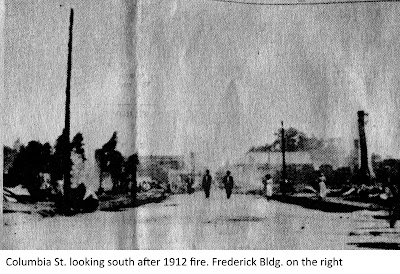During his research projects with the Covington Heritage Foundation, Jack Terry has come across a great deal of information about these fires, using early Sanborn Fire Insurance maps, newspaper accounts of the time, and census records to document the damage these fires did to specific buildings and downtown Covington as a whole.
Click on the images and newspaper articles to see them in a larger size.
The aftermath of one of the downtown Covington fires
The first fire to destroy a significant portion of downtown Covington was on November 11,1898. This fire which started in the Town Hall which was in the middle of the block bounded by Columbia, Boston Rutland and Florida. The New Orleans Daily States of Nov 11, 1898, provides details of the buildings that were destroyed on Columbia Boston Rutland and Florida streets as a result of the fire.
According to the St Tammany Farmer all of the buildings burned with the exception of a brick building owned by Hardy Smith were frame structures and represented little value.
Frame construction was the norm in Covington. It wasn’t until mid-1905 that the city passed an ordinance that required the approval of detailed plans for any building or repair that cost more than $50.00.
Nevertheless by 1909 the Sanborn Fire Insurance Company map of Columbia street between Boston and Rutland showed frame construction was still the norm. Only four of the buildings damaged in the 1898 fire were reconstructed with bricks by 1909.
The second serious fire that devastated portions of downtown Covington occurred August 23, 1906. According to newspaper accounts the fire started in the store of Mr. W. N. Patrick on Columbia street. The fire spread across the street and destroyed Preston Burns store, home and cottage located at the NW corner of Lockwood and Columbia as well as a number of other buildings on Columbia between Gibson and Kirkland.
Map of Buildings Damaged Along Columbia Street in 1906
In October 1908, the citizens created the Covington Benevolent and Fire Protective Association for the protection of their properties from fire losses. Emile Beaucoudray was elected Chief of the fire department and J. L. Smith elected assistant chief. In early 1909 the fire company decided to procure a fire engine for the Bucket Brigade at a cost of $750. Covington’s new fire engine was guaranteed to force water through 1500 feet of hose a distance of 160 feet.
Nevertheless, the new fire department had serious problems fighting the third significant fire to strike Covington in less than 12 years. The Covington House hotel located on Rutland caught fire and spread rapidly because strong winds. The fire also consumed the Masonic hall, several cottages, and the warehouse of the Jones and Pickett Company.
According to an October 30th article in the St Tammany Farmer the fire department was hampered by an insufficient supply of water caused by the incompatibility of the two and one eight couplings on the fire plugs with the two-inch fire hoses and obstructions in a second line. Only a wind shift and the dedicated work of the volunteer fire fighters kept this fire from spreading to the entire business district.
The fourth and most disastrous fire to devastate Covington occurred on June 12, 1911. The photograph above shows Columbia street prior to start of the fire. According to newspaper accounts the fire started in the barn of Joseph Brocato’s by children playing with matches. The fire department attempted to contain the fire near Brocato’s store however it soon spread to the adjoining two story Frederick building. The combination of a brisk breeze, an inadequate supply of water, intense heat and fears that the Frederick building would collapse on the firefighters resulted in the fire spreading across Columbia street and destroying all the buildings on both sides Columbia between Boston and Rutland. In addition, the fire jumped Rutland street and destroyed the Masonic Temple recently rebuilt after the 1909 fire and a cottage owned by Frederick and Singletary.
The fire also jumped Boston street to the Wherli building directly across from the Frederick building. Firefighters however prevented this building from burning and spreading to the wood frame buildings on that side of Columbia by using water from a tank H J Smith constructed for protection of his store.
Local newspapers articles shown below provide more detail about of this devastating fire and the businesses impacted by the fire.
The map below shows the location of businesses and homes destroyed in the fire on the 1909 Sanborn Fire Insurance Map.
By 1915 the Frederick building, the Covington Bank and Trust bank, and a one-story H H Smith building were restored and are major attractions in present day historic Covington. From the records, it is unclear if the restoration used the burned-out shell of these buildings in their reconstruction.
Then, again in 1920, there was another major fire in downtown Covington, this one close to the Southern Hotel building. Read about it in the newspaper article below. Click on the image to enlarge the view.
As a result of fires, natural disasters and demolition very few late 19th century buildings remain in downtown Covington’s Historic District.
Some of the early fire hydrants can still be seen around Covington. (Photos by Jack Terry)














